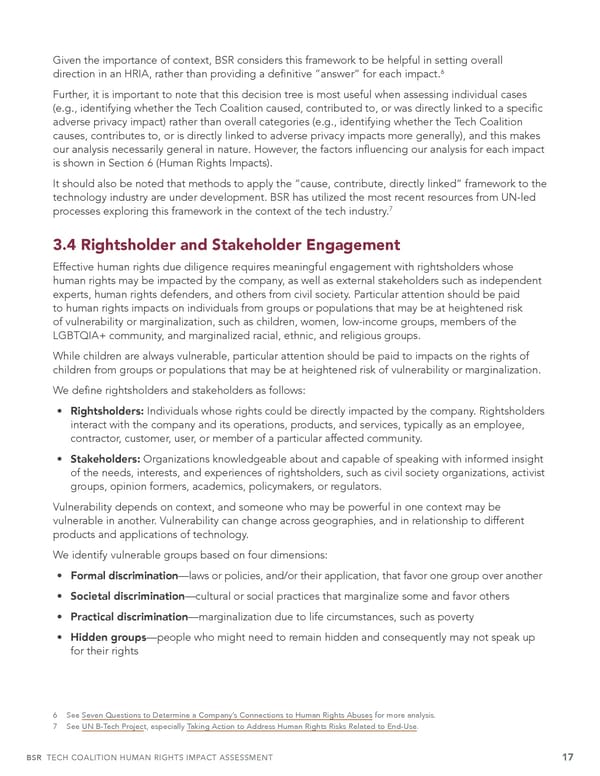Given the importance of context, BSR considers this framework to be helpful in setting overall 6 direction in an HRIA, rather than providing a de昀椀nitive “answer” for each impact. Further, it is important to note that this decision tree is most useful when assessing individual cases (e.g., identifying whether the Tech Coalition caused, contributed to, or was directly linked to a speci昀椀c adverse privacy impact) rather than overall categories (e.g., identifying whether the Tech Coalition causes, contributes to, or is directly linked to adverse privacy impacts more generally), and this makes our analysis necessarily general in nature. However, the factors in昀氀uencing our analysis for each impact is shown in Section 6 (Human Rights Impacts). It should also be noted that methods to apply the “cause, contribute, directly linked” framework to the technology industry are under development. BSR has utilized the most recent resources from UN-led 7 processes exploring this framework in the context of the tech industry. 3.4 Rightsholder and Stakeholder Engagement Effective human rights due diligence requires meaningful engagement with rightsholders whose human rights may be impacted by the company, as well as external stakeholders such as independent experts, human rights defenders, and others from civil society. Particular attention should be paid to human rights impacts on individuals from groups or populations that may be at heightened risk of vulnerability or marginalization, such as children, women, low-income groups, members of the LGBTQIA+ community, and marginalized racial, ethnic, and religious groups. While children are always vulnerable, particular attention should be paid to impacts on the rights of children from groups or populations that may be at heightened risk of vulnerability or marginalization. We de昀椀ne rightsholders and stakeholders as follows: • Rightsholders: Individuals whose rights could be directly impacted by the company. Rightsholders interact with the company and its operations, products, and services, typically as an employee, contractor, customer, user, or member of a particular affected community. • Stakeholders: Organizations knowledgeable about and capable of speaking with informed insight of the needs, interests, and experiences of rightsholders, such as civil society organizations, activist groups, opinion formers, academics, policymakers, or regulators. Vulnerability depends on context, and someone who may be powerful in one context may be vulnerable in another. Vulnerability can change across geographies, and in relationship to different products and applications of technology. We identify vulnerable groups based on four dimensions: • Formal discrimination—laws or policies, and/or their application, that favor one group over another • Societal discrimination—cultural or social practices that marginalize some and favor others • Practical discrimination—marginalization due to life circumstances, such as poverty • Hidden groups—people who might need to remain hidden and consequently may not speak up for their rights 6 See Seven Questions to Determine a Company’s Connections to Human Rights Abuses for more analysis. 7 See UN B-Tech Project, especially Taking Action to Address Human Rights Risks Related to End-Use. BSR TECH COALITION HUMAN RIGHTS IMPACT ASSESSMENT 17
 Tech Coalition Human Rights Impact Assessment of the Lantern Program Page 16 Page 18
Tech Coalition Human Rights Impact Assessment of the Lantern Program Page 16 Page 18